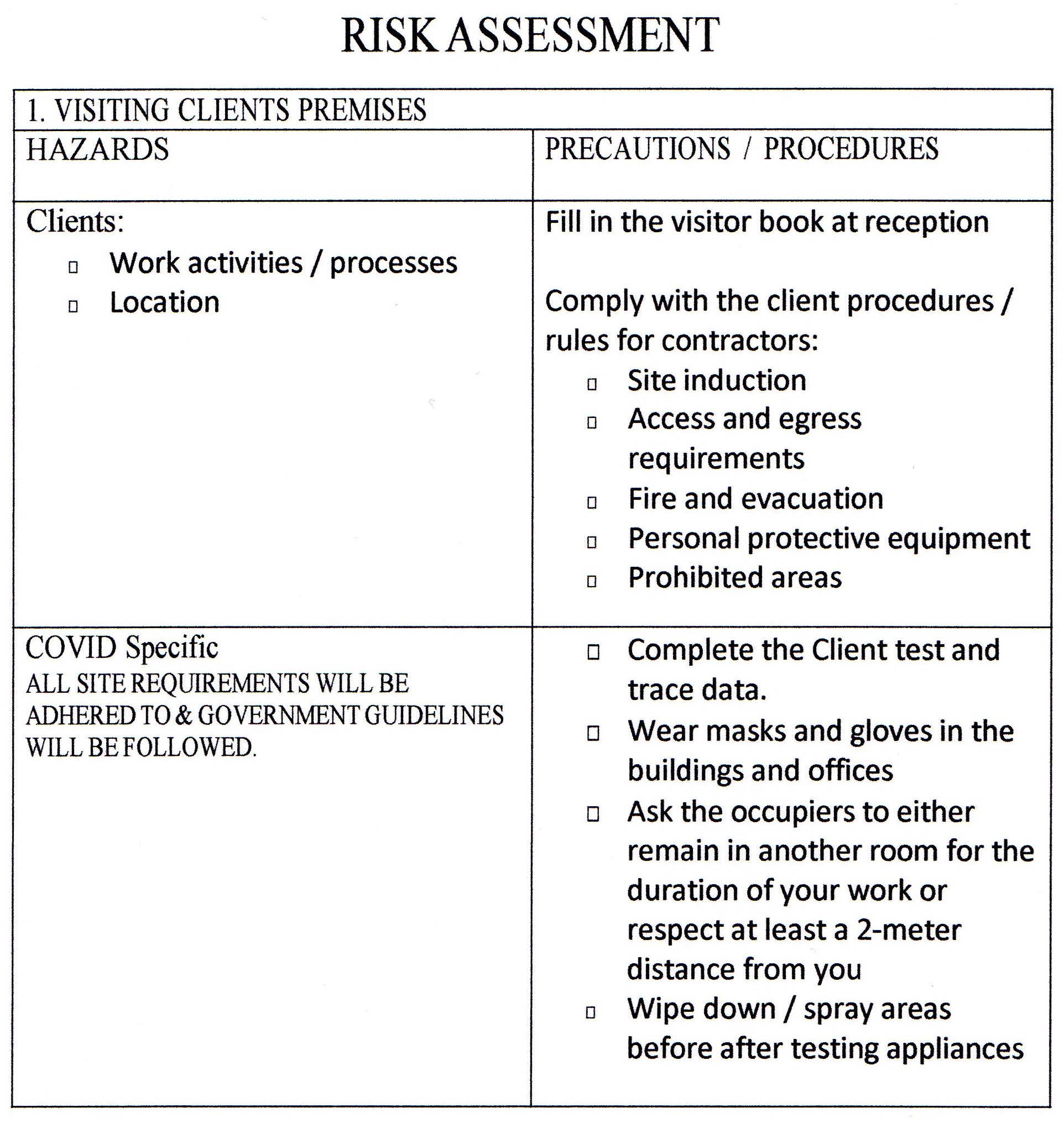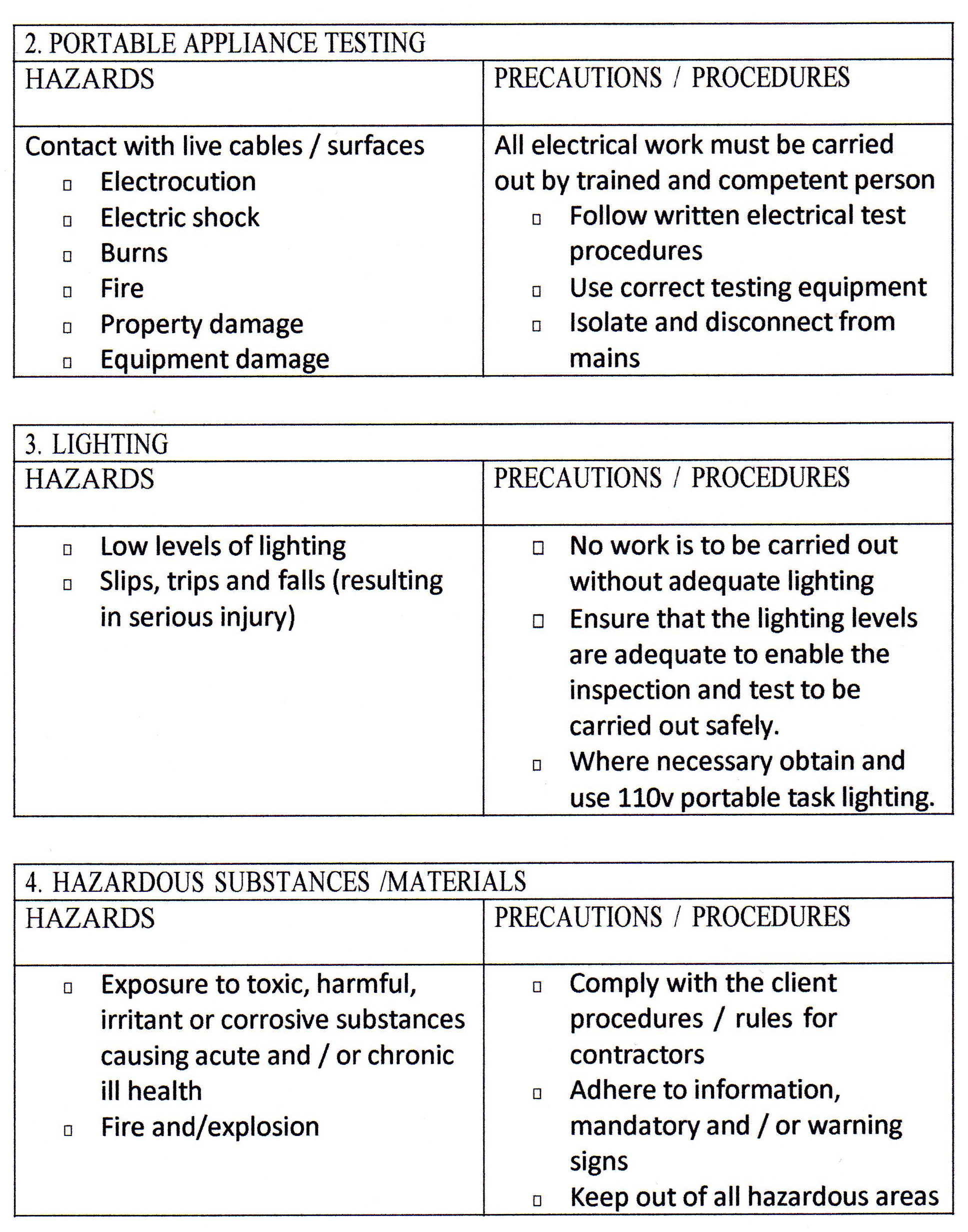Legal Stuff
Risk Assessment




LEGAL REQUIREMENTS
The legislation of specific relevance to electrical maintenance is the Health & Safety at Work Act 1974, the Management of Health & Safety at Work Regulations 1999, the ectricity at Work Regulations 1989, the Workplace (Health, Safety and Welfare) Regulations 1992 and the Provision and Use of Work Equipment Regulations 1998.
The Health & Safety at Work Act 1974 puts the duty of care upon both the employer and the employee to ensure the safety of all persons using the work premises. This includes the self employed.
The Management of Health & Safety at Work Regulations 1999 states:
"Every employer shall make suitable and sufficient assessment of:
(a) the risks to the health and safety of his employees to which they are exposed whilst at work, and
(b) the risks to ensure the health and safety of persons not in his employment arising out of or in connection with the conduct by him or his undertaking."
The Provision and Use of Work Equipment Regulations 1998 states:
"Every employer shall ensure that work equipment is maintained in an efficient state, in efficient working order and in good repair."
The PUWER 1998 covers most risks that can result from using work equipment. With respect to risks from electricity, compliance with the Electricity at Work Regulations 1989 is likely to achieve compliance with the PUWER 1998.
PUWER 1998 only applies to work equipment used by workers at work. This includes all work equipment (fixed, transportable or portable) connected to a source of electrical energy. PUWER does not apply to fixed installations in a building. The electrical safety of these installations is dealt with only by the Electricity at Work Regulations.
The Electricity at Work Regulations 1989 states:
"All systems shall at all times be of such construction as to prevent, so far as reasonably practicable, such danger."
"As may be necessary to prevent danger, all systems shall be maintained so as to prevent, so far as reasonably practicable, such danger."
"'System' means an electrical system in which all the electrical equipment is, or may be, electrically connected to a common source of electrical energy and includes such source and such equipment"
"'Electrical Equipment' includes anything used, intended to be used or installed for use, to generate, provide, transmit, transform, rectify, convert, conduct, distribute, control, store, measure or use electrical energy."
Scope of the legislation
It is clear that the combination of the HSW Act 1974, the PUWER 1998 and the EAW Regulations 1989 apply to all electrical equipment used in, or associated with, places of work. The scope extends from distribution systems down to the smallest piece of electrical equipment.
It is clear that there is a requirement to inspect and test all types of electrical equipment in all work situations.
Method Statement
Site Approach
Upon arrival on site our test engineer will introduce himself to the client’s representative and explain the purpose and nature of the work to be carried out. This person will then be asked to accompany our engineer around the site to highlight any sensitive areas and introduce the IT manager who should confirm any arrangements that have been made for shutting down any IT workstations.
Standards
The inspection and testing shall be carried out in accordance with the requirements of the following regulations and publications:
Electricity at Work Regulations 1989
Health & Safety at Work Act of 1974
IEE Code of Practice for the in service inspection and Testing of Portable Electrical Equipment
Identification of equipment
Every piece of electrical equipment will be allocated a Asset ID / number. This will be used to cross reference test results to the certificate supplied. A register of equipment will then be produced to include the following details:
Asset number
Location in which the appliance/asset is kept/used
Description of appliance
PASS / FAIL result for tests completed
Date of test
Testing Procedures as stated by the IEE Code of Practice for In service Inspection and
Testing or Portable Electrical Equipment.
Visual Inspection
A visual inspection of the appliance shall be carried out prior to any testing. The inspection includes the following:
Socket Outlet is there any evidence of overheating, cracks or damage?
Plug is the flexible cable secure, are the pins insulated, is it free from cracks, or damage and signs of overheating?
Flex is in good condition, free from cuts, fraying or damage?
Appliance does it work? . Is it free from damage? . Can it be used safely?
In addition, the visual inspection will check that the means of disconnection from the mains supply is also readily accessible and that wherever possible, flexible cords are positioned so that they do not present a hazard.
All minor faults identified during the visual inspection, such as incorrectly rated fuses, damaged 13amp plugs, loose connections will be rectified prior to the testing procedure.
Testing
Subject to a satisfactory visual inspection, the following sequences of test are carried out.
Earth continuity – Class 1 appliances only
Insulation resistance (where appropriate)
Operation/load test
Earth leakage test
Labelling
A sample of the labels we use is shown here. Any FAILED appliances are taken out of service and are
immediately brought to the attention of the client representative on site.
Report
Upon completion a report is produced usually within 5 working days listing the appliances tested, the results of the tests performed, and details of any remedial repairs necessary. We also provide the engineers observations on all failed equipment.

